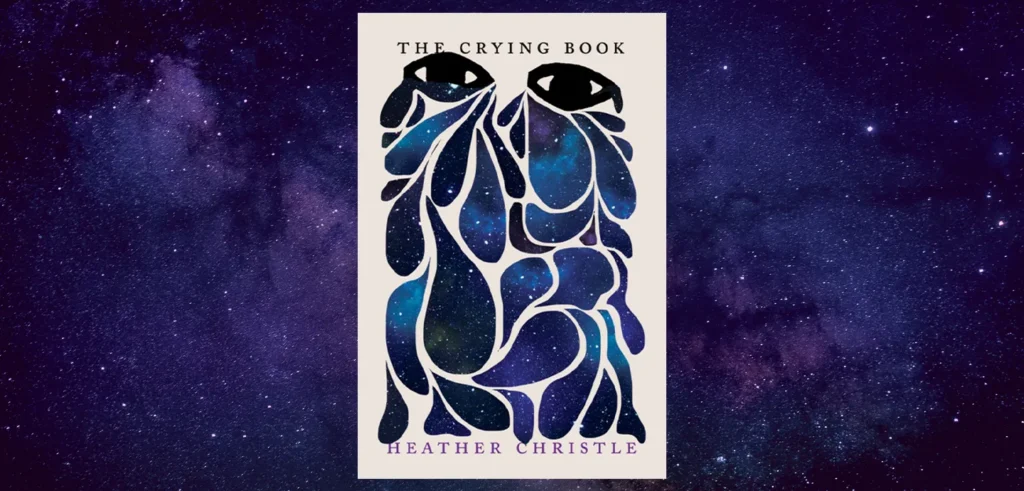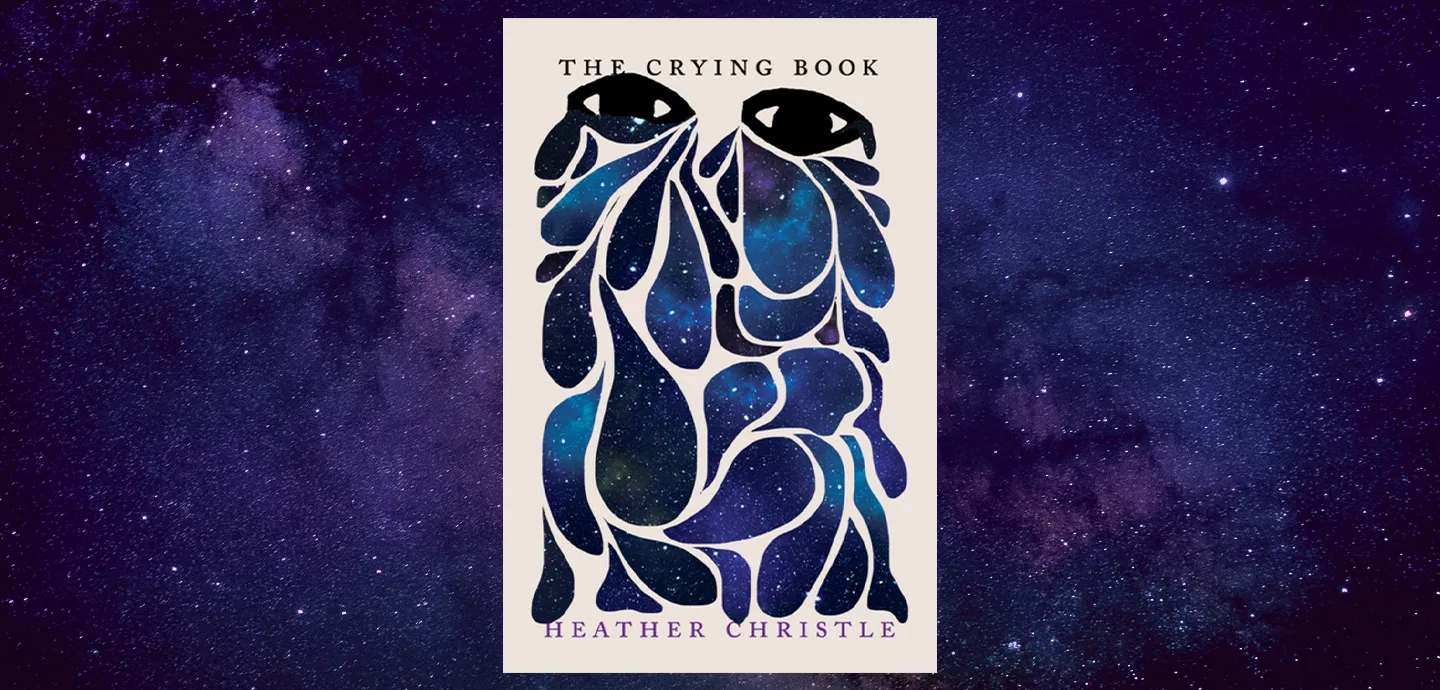Written by Heather Christle, The Crying Book delves into the act of crying, examining its causes and the various meanings and social implications it draws upon. More, in this review below.
Heather Christle’s The Crying Book does not literally cry despite what its cover art may portray, but there are moments in there that can make the reader come close to tears themselves. Published in 2019, this book goes beyond the simple definition of crying as a reactionary outcome. It sets out to dissect the strangeness and often confusing aspects of one of the most complex emotions, which is evident when she writes,
“Some mornings I awake with an enormous sensation inside me and cannot identify whether the urge is to cry or write a poem or fuck someone. All at once? My body has cross-indexed the impulse.”
The Crying Book is a moving examination of the act of crying, what causes it and the myriad meanings behind it. But that is not all; Christle goes on to dig deeper into an exploration of the many kinds of crying and their social implications. She sets out to reveal how this simple, most basic verb exists in the human world, media, myths, legends, and even the animal kingdom.
Christle writes in the introductory note that she started writing this book as a sort of map of all the places she had cried in. Starting around a time in her life when she would often find herself in tears without any rhyme or reason. There is no doubt that this phenomenon is something that most of us have dealt with more often than not and has left us with more questions than answers. Although Christle started working on this book as a way of documenting her condition, somewhere along the way, it grew to be more extensive – something that could hold all of her findings on crying.
Summary of The Crying Book
Written in sections through a constellation of her findings, the text reads like a lyrical essay, which works quite effectively in breaking the monotony of reading through just research or solely personal anecdotes. Christle moves swiftly between fragments from talking about her losing a friend to suffering a miscarriage to discussing ‘some people’s’ avoidance tactic to swans to laying out her findings on the emotional spectrum of elephants. She does all of this deftly without losing the intimacy she builds with the reader through sharing her own deeply personal stories.
“Twice I cried hysterically while driving. Once, sixteen, and without money for the toll or a sense of how I might live the next day. Once, twenty-one, and mid-move, with a car full of belongings and the sudden apprehension that I had driven an hour in the wrong direction. If you cry in the car while it’s raining, it feels like the windshield wipers should tend too to your face. Comfort words, comfort arms, comfort swipe.”
It is the vulnerability that Christle exposes with care that makes this book such a riveting read. She approaches crying from all angles. Are they distress signals pointing toward sadness or anguish? If they are, why do we lie to keep people from knowing that we are crying?
The part autobiographical, part reflective voice on gathered stories, scientific findings, historical research, archived news, and personal anecdotes from the world at large works well as the author weaves her journey to motherhood along with these findings – a sort of interaction of the interior with the exterior emerges to show how seemingly mundane things like shapes, colour, animals, the moon, even synonyms can become a metaphor for grief. The most interesting sections, however, were those at the intersection of crying and subjects of patriarchy, imperialism, racism, sexism, and such other social phenomena.
She addresses the social cues that the act of crying subtly reveals.
More often than not, the narrator deals with the duality of being. Looking inward, she becomes the narrative. In that process, we witness these cues revealing themselves.
“I cried at school for a reason I cannot recall, and afterward a popular boy—rattail, skateboard—told me I looked like a druggie, and I was so pleased to be seen I made him repeat it.”
“The length of the cry matters. I especially value an extended session, which gives me time to become curious, to look in the mirror, to observe my physical sadness.”
But it is not only Christle who stands in front of the mirror to examine herself closely while crying. In one instant, she asks, “Do you remember the hopelessness of watching a parent cry?” and lets this question hang by itself.

Also Read: Reading A Soldier’s Mind in ‘At Night All Blood is Black’ by David Diop
Is Crying Actually Worth It?
This book makes the reader retrace all the times they have cried before – the significance of those occasions, the hidden meanings that are yet to come to the surface. This, in and by itself, is a very hard job to accomplish for a writer, but given that one of the effects of this book is that of normalising the most emotional of all emotions, one does feel emboldened to embark on one’s own exploration.
Christle does a remarkable job of navigating the entire distance of the subject in question by exploring crying as –
- a woman’s weapon – one of the popular narratives is that crying is a sign of powerlessness among women and is often used by them to get the better of a losing situation. Christle goes on to then describe how Yi-Fen Chen, a design student, used the metaphor quite literally to create the Tear Gun.
- a way for men to assert their gender by resorting to emotional deprivation – as Christle finds, “A survey of Virgin Atlantic passengers found that 41 percent of men “said they’d hidden under blankets to hide their tears,” while women “reported hiding tears by pretending they had something in their eye.”
- a performance – as in the case of Shirley Temple, who can only cry on cue before lunch
- a release – an outcome of sadness
- an enigmatic response by the body – immense anger leading to tears rather than violence
- a surprise reaction to other elements like food, pollen, snowflakes or spice
- as a diversion tactic – as Christle shares from her finding how “They can be a form of defense against an imagined aggression, a way of shutting down a conversation the white person finds hurtful.” How racism manifests in “white lady tears” when almost always they trump the black people’s tears and their experience of the same event in question
- As a means of racial discrimination – as is evident from Lucille Clifton’s response poem when “Alvin Borgquist, a white graduate student at Clark University in Massachusetts, published the first in-depth psychological study on crying.” He claimed that his study was “extensively supplemented by ethnological data” when his standard questionnaire was shared with white subjects only without any efforts of greater inclusion from his end.
- for grieving
- for garnering sympathy
Why You Should Read The Crying Book
If you are someone who cries watching animated movies and wonders why or know someone who has trouble crying even at funerals, this book is for you. And for anyone who ponders any one of these questions – Is vulnerability a strength or a weakness? Does crying often equal to unraveling of the mind? What does it mean when one cries in the kitchen, and is it better to cry in the bathroom or a parking space? In short, this book is for everyone wanting to be led to innumerable self-epiphanies.
Throughout the book, the act of crying seems isolating, embarrassing and even uncomfortable. However, it also drives home the point that it is a manifestation of our humanity even when it is not an easy or straightforward process. One often tends to overthink it. The ending of the book drives home the point that we are all existing between moments of pain or flickers of light, it depends on us as to how much we accept as essential to our emotional landscape.
By the Same Author: How We Fight for Our Lives by Saeed Jones (Review)

